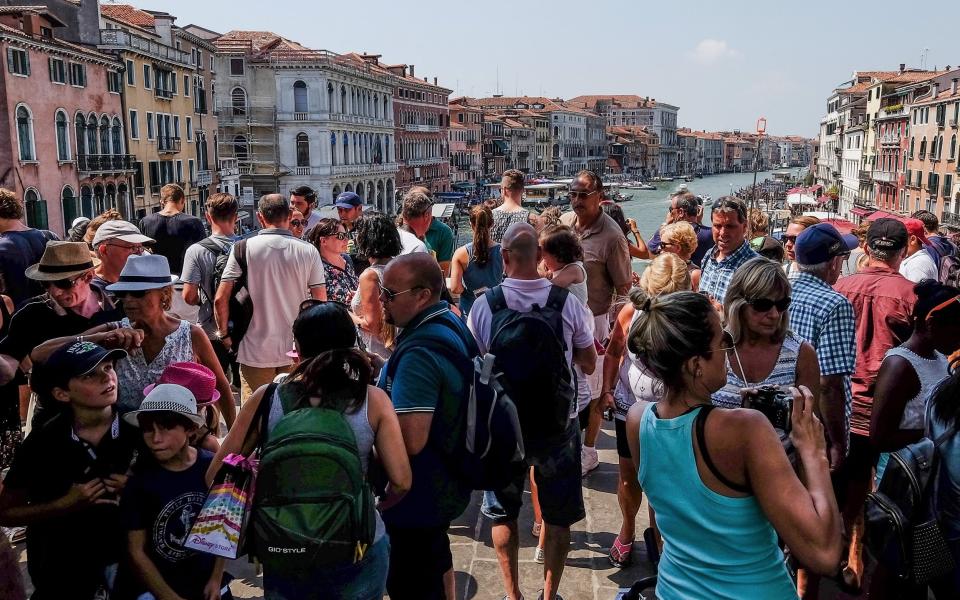You would think that Italy, the country that basically invented tourism, would have figured out how to manage tourism by now. However, this is not the case. And we, ordinary tourists, pay the price for this.
Tourist flight is a global problem, but the destination making headlines this week is Venice, which is pushing to charge a €5 (£4.30) entrance fee for day-trippers, among other tourism control measures. In the 17th century, when nobles visited Venice as part of the Grand Tour, daily arrivals numbered in the dozens. Today, during peak periods, the floating city (which spans just 2.7 square miles) can accommodate as many as 110,000 tourists a day.
The issue of overtourism in Venice is as talked about as the worn-out old steps of the Rialto Bridge. Unesco has threatened to add the overcrowded city to its list of heritage at risk, and Venice city authorities periodically announce new measures to solve the list of problems they face. For example, cruise ships are banned from docking in the old city in 2021, and more changes are on the horizon. Starting from June 2024, tour guides will be prohibited from shouting over loudspeakers, and the groups they lead will not be allowed to exceed 25 people.


Both sensible measures, but the benefits of a €5 (£4.34) entry fee are less obvious. Venice tourism councilor Simone Venturini, who announced the fee in September, said it would “discourage day tourism during certain periods”. But at a price point lower than a fridge magnet, it’s hard to see many tourists turning up at the doors. The fact that the money collected is spent only on covering systemic costs, not on the restoration of the city, makes this meaningless.
In other corners of Italy, unprepared tourists may find themselves coughing up much higher sums. In April 2023, Portofino’s mayor announced that two of the village’s most popular spots would become a “red zone”; If you linger at these photogenic spots for too long, you could face fines of up to €275 (£238). Meanwhile, in Florence, you can pay to “skip the line” at some art galleries; However, there is no guarantee that you will not face a (even if shorter) wait when you arrive.
There is more. Sit on Rome’s Spanish Steps and you could be fined up to €250 (£217) (rising to just under £350 if you damage the steps), wander around Sorrento in a bikini and you could be slapped with €500 (£433). If you pay a bill, play football on the shores of Lake Garda you could be liable for €600 (£520), walk the paths of Cinque Terre in flip-flops and you risk coughing up €2,500 (£2,167). Most peculiarly, building a sandcastle on a particular beach in Eraclea (near Venice) carries a fine of up to 250 Euros (£217). Happy holidays, kids.


Less controversially, some parts of Italy have a tourist tax, which can range from 87p to £6 per night, depending on the star rating of your accommodation and the length of your stay. This isn’t unique to Italy (even Manchester has introduced a £1 tax in 2023), but the jury is out on whether tourist taxes are an effective method of managing overtourism.
As of this week, Amsterdam increased its tourist tax, the highest tax in Europe, from 7 percent to 12.5 percent of hotel room rates. The city tariff applied to cruise passengers has also increased. British author Callum Booth, who lives in Amsterdam, says: “The tourist tax appears to be a measure to line local government pockets rather than a policy designed to make a real difference to tourist numbers and types of visitors to Amsterdam.”
Barcelona’s tourist tax (which starts at £2.38 but is expected to rise in April) also had little impact on figures: “We haven’t seen the tax increase impact demand,” says sales marketing manager Natasha Thorne. the four-star Casa Bonay. “But we don’t care about taxes. “Barcelona is a densely populated city with a lot of tourists, and if this needs to be compensated by a tax, we certainly agree with that.”
Justin Francis, co-founder of Responsible Travel, says the usefulness of tourist taxes depends on how local authorities spend them. “The two main beneficiaries of the 5 percent room night tax in U.S. Lancaster County are the tourism board and the convention center; neither residents, their cultural and natural heritage, nor most visitors benefit,” he notes.
As global restrictions on bad tourist behavior intensify, we expect more fines to be imposed in holiday hotspots. And like it or not, entrance fees and nightly tourist taxes aren’t going anywhere. Bali, Valencia and Iceland are among the places where new taxes will be introduced for 2024. More to come.
The only mercy is that in almost all cases, entrance fees and tourist taxes are rarely so prohibitively high as to make a holiday unaffordable. Make sure you don’t sit on the wrong steps or build a sandcastle on the wrong beach; so you can get on the right track to your next mortgage repayment.